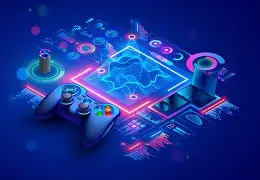Artificial intelligence in gaming—AI gaming—is rapidly reshaping the video game landscape. From procedural world-building to hyper-smart NPCs, AI-powered experiences are evolving player interaction, developer workflows, and industry norms. This article explores major trends, real-world applications, benefits, ethical dilemmas, and what lies ahead for AI gaming in 2025.
- 1. Generative AI & Procedural Content Generation (PCG)
- Your Attractive Heading
- 2. Smart NPCs & Adaptive Gameplay
- 3. Hyper-Realistic Visuals via AI Upscaling & Ray Tracing
- 4. Personalized Storytelling & Voice-Driven Dialogue
- 5. AI-Driven Game Testing & Development Efficiency
- 6. Cloud Gaming, Cross-Platform Play & Esports Integration
- 7. Ethical & Legal Challenges in AI Gaming
- 8. Industry Momentum & Future Outlook
- Conclusion
1. Generative AI & Procedural Content Generation (PCG)
One of the most transformative trends in AI gaming is procedural content generation (PCG). AI models now autonomously create dynamic maps, quests, 3D assets, music, and more. By designing vast game worlds in real time—like in No Man’s Sky—PCG enhances replayability and streamlines development.
Your Attractive Heading
- Asset creation: Tools such as MidJourney produce textures and models in seconds.
- Dynamic levels: Environment layouts and mission structures adapt to player choices.
- Soundscapes & music: AI composes scores that shift based on gameplay moments.
PCG not only speeds up production but also enables deeply personalized gaming experiences.
2. Smart NPCs & Adaptive Gameplay
AI-enhanced NPCs are no longer scripted mannequins. They now adapt and learn:
- Reinforcement learning allows NPCs to study player behavior and evolve strategies.
- Emotional intelligence enables characters with evolving goals, memory, and social networks.
- Indie and AAA studios alike are integrating adaptive difficulty, where game challenge adjusts in real time to player performance.
These advances enrich gameplay, making each session uniquely responsive.
3. Hyper-Realistic Visuals via AI Upscaling & Ray Tracing
Graphics in AI gaming have leaped forward:
- DLSS and FSR: NVIDIA’s DLSS 4 and AMD’s FSR 4 use machine learning to upscale lower-resolution assets to high-fidelity visuals.
- Next-gen handhelds—like Nintendo Switch 2—utilize these technologies to deliver stunning visuals with limited hardware.
- Ray tracing is accelerated by AI, enhancing lighting, reflections, and realism.
AI-enabled graphics tools democratize photo-realism across devices.
4. Personalized Storytelling & Voice-Driven Dialogue
AI empowers narrative experiences:
- Voice synthesis: NPCs with AI-powered speech offer dynamic dialogue—like Fortnite’s AI-powered Darth Vader.
- Adaptive narrative: AI adapts story routes based on player preferences, reminiscent of Netflix-style choices.
- Ethical caution: Deep-fake voices reignite debates around talent rights and safety.
While immersive, the tech demands strong ethical guardrails.
5. AI-Driven Game Testing & Development Efficiency
On the backend, AI boosts efficiency:
- QA automation: AI bots test thousands of scenarios to identify bugs faster.
- Asset generation: Developers save on manual creation by leveraging generative tools.
- Faster production cycles: Studios report reduced dev time by 30–40% using AI tools.
AI now complements creativity by handling repetitive tasks.
6. Cloud Gaming, Cross-Platform Play & Esports Integration
AI is also powering connectivity:
- Cloud gaming: Predictive AI smooths performance and adapts quality on the fly.
- Seamless cross-play: AI headsets future-proof cross-device compatibility.
- Esports coaching: AI analyzes pro play to provide training insights and referee systems in real time.
This enhances accessibility and reshapes competitive gaming.
7. Ethical & Legal Challenges in AI Gaming
AI gaming carries notable concerns:
- Labor displacement: AI voice and motion capture tools spark pushback from actors’ unions.
- Data privacy: Personalized gaming requires collecting player data—raising transparency debates.
- AI-generated assets: “AI slop”—low-quality auto content—can harm player trust (e.g., Black Ops 6 controversy).
- Creativity erosion: Over-reliance on AI may diminish original artistic expression.
Ethical frameworks are essential to navigate this transformation.
8. Industry Momentum & Future Outlook
Major players are accelerating the push:
- Microsoft’s Muse can create 3D gameplay on the fly.
- NVIDIA’s RTX 50 series and Cosmos AI models boost in-game realism and asset generation.
- AMD’s Ryzen AI Max CPUs promise next-gen handhelds with high-performance AI graphics.
Indie developers are quickly adopting AI for experimental narrative and gameplay.
Conclusion
AI gaming in 2025 is a powerful blend of creative evolution and technological transformation. From procedural content and smart NPCs to AI-driven graphics and cloud connectivity, the industry is racing toward deeply personalized, immersive experiences. Yet alongside innovation lies complexity—labor ethics, creative integrity, and data privacy must be balanced.
